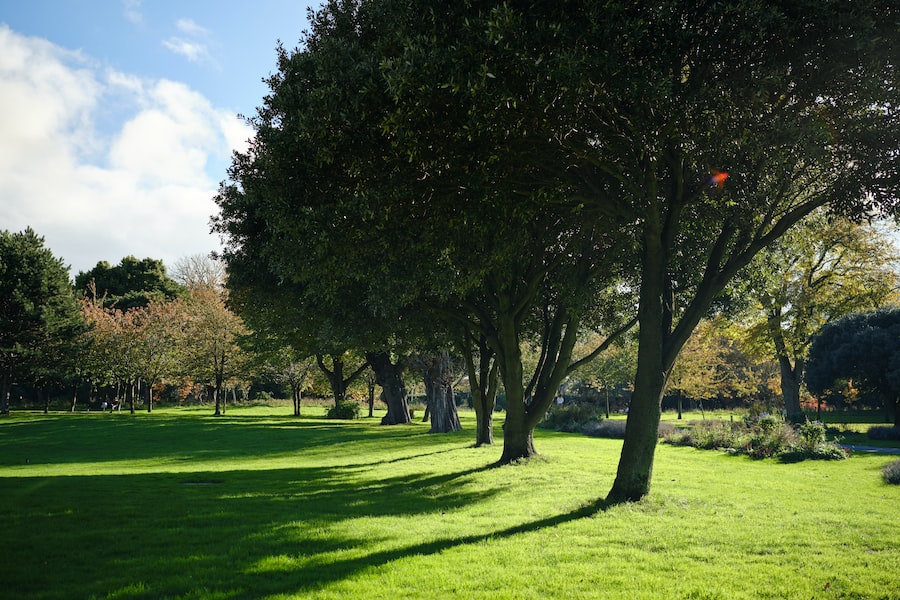Uncovering the Culprit: Exploring the Causes of Holes in Your Lawn

Having a lush, green lawn is a dream for many homeowners. However, one common problem that can ruin the aesthetic appeal of your lawn is the presence of holes. These unsightly holes not only detract from the overall beauty of your outdoor space but can also pose a safety hazard. Understanding the causes of lawn holes and taking appropriate action to address them is crucial for maintaining a healthy and beautiful lawn.
Key Takeaways
- Lawn holes can be caused by a variety of factors, including pests, fungal diseases, improper lawn care, soil issues, and weather conditions.
- Identifying the culprit behind your lawn holes is the first step in finding a solution.
- Pests and rodents can be controlled through traps, repellents, and professional extermination services.
- Fungal diseases can be treated with fungicides and proper lawn maintenance practices.
- Prevention and maintenance, including proper watering, fertilization, and aeration, are key to keeping your lawn healthy and hole-free.
Identifying the Culprit: Common Causes of Lawn Holes
There are several factors that can contribute to the formation of holes in your lawn. Animals and pests, such as moles, voles, and skunks, are often responsible for digging holes as they search for food or create burrows. Fungal diseases can also cause lawn holes, as they weaken the grass and create areas of dead or dying turf. Improper lawn care practices, such as overwatering or mowing too short, can lead to weak grass that is more susceptible to damage. Soil issues, such as compaction or nutrient deficiencies, can also contribute to the formation of holes. Additionally, weather and climate conditions, such as heavy rainfall or extreme temperatures, can cause damage to your lawn.
Digging Deeper: Investigating the Root Causes of Lawn Holes
While it may be tempting to simply fill in the holes and move on, it is important to investigate the root causes of lawn holes in order to effectively address the issue. By understanding the underlying issues that contribute to lawn holes, you can implement targeted solutions that will prevent future damage. For example, if you discover that pests are responsible for the holes in your lawn, you can take steps to control and prevent their presence. Similarly, if you determine that fungal diseases are causing the holes, you can treat your lawn with appropriate fungicides.
Pests and Rodents: How to Identify and Control Them
| Pest/Rodent | Identification | Control Methods |
|---|---|---|
| Ants | Small, black or brown insects with segmented bodies and antennae | Seal entry points, eliminate food sources, use bait or insecticides |
| Bed Bugs | Small, reddish-brown insects that feed on blood and leave bites on skin | Use heat treatment, vacuuming, or insecticides |
| Cockroaches | Large, brown or black insects with flat bodies and long antennae | Eliminate food and water sources, use bait or insecticides |
| Mice | Small, furry rodents with pointed noses and long tails | Seal entry points, use traps or rodenticides |
| Rats | Large, furry rodents with long tails and pointed noses | Seal entry points, use traps or rodenticides |
Pests and rodents are common culprits when it comes to lawn holes. Moles, voles, and skunks are known for digging holes in search of food or creating burrows. Signs of infestation include raised tunnels or ridges in your lawn, as well as the presence of small mounds of soil. To control these pests, you can use traps or repellents specifically designed for their removal. Additionally, making your lawn less attractive to these animals by removing their food sources, such as grubs or insects, can help prevent future infestations.
Fungal Diseases: Symptoms and Treatment Options
Fungal diseases can also cause lawn holes by weakening the grass and creating areas of dead or dying turf. Common fungal diseases that can lead to lawn holes include brown patch, dollar spot, and fairy ring. Symptoms of fungal diseases include discolored or thinning grass, patches of dead or dying turf, and the presence of mushrooms or other fungal growths. Treatment options for fungal diseases include applying fungicides and improving cultural practices, such as proper watering and mowing techniques.
Improper Lawn Care: How Your Habits May Be Contributing to Lawn Holes

Improper lawn care practices can contribute to the formation of holes in your lawn. Common mistakes include overwatering, which can lead to shallow root growth and weak grass that is more susceptible to damage. Mowing too short can also weaken the grass and create areas of bare soil that are prone to erosion and the formation of holes. Additionally, using dull mower blades can tear the grass instead of cutting it cleanly, leading to damage and stress. By adopting proper lawn care habits, such as watering deeply but infrequently, mowing at the correct height, and regularly sharpening mower blades, you can help prevent the formation of holes in your lawn.
Soil Issues: Understanding the Impact of Soil Composition on Your Lawn
The composition of your soil plays a crucial role in the health of your lawn. Common soil issues that can contribute to the formation of holes include compaction, nutrient deficiencies, and pH imbalances. Compacted soil prevents water and nutrients from reaching the roots of the grass, leading to weak and shallow root growth. Nutrient deficiencies can result in thin and weak grass that is more susceptible to damage. pH imbalances can also affect the availability of nutrients to the grass, leading to poor growth and the formation of holes. Solutions for improving soil quality include aerating the soil to alleviate compaction, applying fertilizers to correct nutrient deficiencies, and adjusting pH levels through the addition of lime or sulfur.
Weather and Climate: How Environmental Factors Affect Your Lawn
Weather and climate conditions can have a significant impact on the health of your lawn. Heavy rainfall can lead to waterlogged soil, which can suffocate the roots of the grass and create areas of bare soil. Extreme temperatures, such as heatwaves or frost, can also stress the grass and make it more susceptible to damage. Additionally, drought conditions can cause the grass to become dormant or die off, leaving behind patches of bare soil. Prevention and treatment methods for weather-related issues include proper drainage to prevent waterlogging, providing shade or shelter during extreme temperatures, and implementing proper watering techniques during drought conditions.
Prevention and Maintenance: Tips for Keeping Your Lawn Healthy and Hole-Free
Preventing lawn holes is much easier than dealing with them after they have formed. By implementing a few simple practices, you can keep your lawn healthy and hole-free. First and foremost, it is important to practice proper lawn care techniques, such as mowing at the correct height, watering deeply but infrequently, and fertilizing according to the needs of your grass. Regularly inspecting your lawn for signs of pests or diseases can help you catch and address issues before they become major problems. Additionally, improving the overall health of your soil through proper fertilization and aeration can help prevent the formation of holes.
Taking Action to Restore Your Lawn to Its Former Glory
In conclusion, holes in your lawn can be a frustrating and unsightly problem. By understanding the common causes of lawn holes and taking appropriate action, you can restore your lawn to its former glory. Whether it’s controlling pests and rodents, treating fungal diseases, practicing proper lawn care techniques, addressing soil issues, or mitigating the effects of weather and climate conditions, there are solutions available for every cause of lawn holes. By implementing prevention and maintenance tips, you can keep your lawn healthy and hole-free for years to come. So don’t let those holes ruin the beauty of your outdoor space – take action today!



